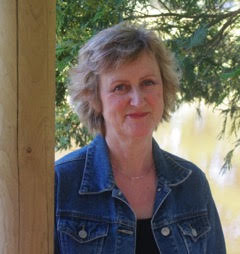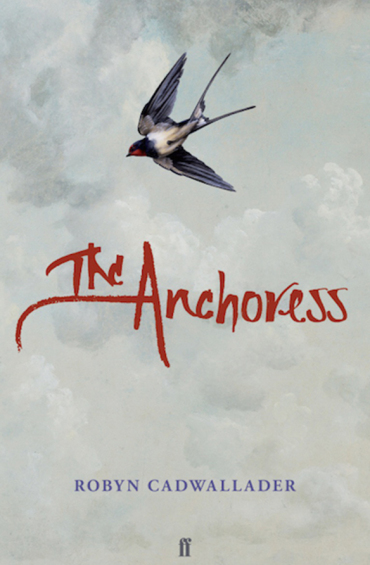Robyn Cadwallader offers advice on how to make a restricted setting compelling.

Thirteenth-century England. Sarah is an anchoress: a religious woman enclosed, voluntarily and for life, in a stone cell nine paces by seven, its door nailed shut, its only windows covered with curtains. No daylight, no way out and no way for anyone to come in. It’s hardly a promising premise for a novel! Why would you even try? Good question! But, for good or ill, the idea wouldn’t let go of me, and so I persevered.
Writing about it now, after the work is finished, it might look as if I sat down, figured it all out, and then pressed on with the writing. But that is far from the truth. It was a matter of exploration, experimentation, false starts and gradually uncovering what it was I needed to do. But, to avoid immersing you in the tangle of all that, I’ll summarise what I discovered along the way.
The overarching way in which I found the energy necessary for a novel was to take myself as deeply as possible inside Sarah, emotionally, physically and mentally. All else had to flow from and back to her. Looking back, I used three main elements: I followed my own interest in the subject; I made a virtue, not a blockage, of the difficulties, and I took risks.
1. I followed what most interested me about anchoresses
I was interested in the physical experience of such enclosure: what would it be like to live alone, in semi-darkness illuminated only by oil lamps or candles? The cells, or anchorholds, were usually built on the side of a church in a town or village. I was intrigued by what seemed to me significant paradoxes. Firstly, her Rule of Life counselled her to deny and contain her senses so that she could focus on God, and yet it seemed to me that someone denied sight and physical contact would have all her other senses heightened. Secondly, in the cell, she was to be shut off from the world and yet, because the cell was attached to the village church, the physical, social and religious centre of village life, she would be enclosed, but also in the centre of community life.
I was interested in my anchoress’s humanity. I had researched the details of the religious beliefs of the time and the religious obligations of an anchoress, but I believe strongly that those beliefs do not exist separately from the particularity of each person. Commitment to God, and in this case, to enclosure, is a multi-stranded dynamic informed by a person’s individual personality, desires and experience. To my mind, this opens up the world of the novel.
2. I sought to make a virtue, a possibility, from every apparent limitation
This was one of the most important strategies for me. In some ways, a novel set inside a small cell is its own limitation, but instead of trying to avoid the difficulties, such as restrictions on Sarah’s movement and her access to the world outside, I dug deeper into it.
I explored and imagined Sarah’s physical and emotional experience as deeply as I could.
I decided that I would need to stay inside the cell, with Sarah, and write in first person. That in itself was a severe limitation, but after brief experiments with a third person perspective, I knew it had to be first person. I spent time sitting, imagining darkness and narrowness, becoming aware of every sense and feeling: the acute sense of sounds and smells of everyday living just outside her stone walls; an increased awareness of everything her skin touched, and the focused taste of even the most ordinary food; the fears, claustrophobia, hunger, sexual desire, frustration ....
I explored character.
Instead of hunting for ‘thing to happen’ that I might somehow apply to my anchoress’s situation, I went deeper into my main character, Sarah. Who is she? Why is she there? What are her motivations, hopes, desires, fears? And the central question for character: What is her deepest yearning? (On this, see Robert Olen Butler, From Where We Dream.) Does her experience of being enclosed answer that yearning? If not, what tensions arise in her? Being in touch with these issues would give the novel energy, whatever the plot.
I knew back story would be important, but it would be unsatisfying to overuse flashbacks, as if they were the narrative focus. I decided to provide brief memories of the past only when triggered by Sarah’s ‘real time’ experience — often a sense experience or a strong emotion. This way, I would maintain the focus on Sarah and the cell, but expand and intensify both narrative and character.
I explored the implications of Sarah’s interaction with her wider situation.
An anchoress would usually have two maids who lived in a room next to hers, one younger, who cared for her physical needs, and one older, who prayed and read and generally protected the recluse from unwanted visitors. Both were under Sarah’s authority and guidance. The questions were many: what were these women like? How did they relate to one another, living at such close quarters? Was there jealousy for the anchoress’s attention? How did the age disparity play out?
The anchoress also had visits from village women who came for counsel. The women were not allowed to see Sarah, and though their contact was physically limited, their relationships would necessarily be quite intimate. That in itself offered a fascinating dynamic: Sarah is young, finding her way as an anchoress and yet, as a holy woman, expected to be wise on matters of God, as well as marriage, reproduction and the daily tensions of village life.

By allowing the women to speak of their life at home or in the fields, and of village / manor politics, Sarah (and the reader) begins to ‘see’ and understand that the village and all its concerns must be hers as well.
Sarah’s confessor, Ranaulf, visits weekly and the two are forbidden to see one another. I discovered that the limitation on sight actually adds elements of mystery, hiddenness and tension that are destabilising for both of them. Any glimpse or touch, or even their suggestion, however necessary or inadvertent, become freighted with significance and power.
I provided some relief
The cell, I was sure, would be claustrophobic — most likely for Sarah, for the reader, and it certainly was for me! (I only realised how hard it had been to stay inside the cell once the novel was finished and I was ‘released’.) So, to prevent the narrowness becoming overwhelming, while still maintaining the general atmosphere so central to Sarah, I moved outside the cell by depicting Sarah’s confessor, Ranaulf, from third-person limited perspective. I wanted to offer a metaphorical breath of fresh air, and a walk or two along country lanes with Ranaulf, but not so much that we forget what Sarah is feeling. We see a little of the world outside, but are privy to Ranaulf’s experiences only, and mostly focused on his relationship to Sarah.
I created a cat that stubbornly takes up residence in the anchorhold, and a young girl, Eleanor, who visits often and asks awkward questions — perhaps the questions the reader might be asking. Both characters, by their very physical presence, ‘open up’ the cell and challenge Sarah’s unrealistic commitment to purity.
3. I took risks
I’m a great believer in the idea, not that you write what you know, but that you write what you don’t know about what you know. I researched extensively and used that as a base, but there was still a lot I didn’t know about anchoresses, and so I had to imagine; that often meant taking a personal imaginative plunge into very unfamiliar and very uncomfortable realms. There were times I had to take a breath and just try out ideas and strategies. And, even when writing the tough scenes, I let myself play a little with the words.
Robyn Cadwallader lives in the country outside Canberra, Australia. She has published poems, prize-winning short stories and reviews, a non-fiction book about virginity and female agency in the Middle Ages (2008), a poetry collection, i painted unafraid (2010), and an edited collection of essays on asylum seeker policy, We Are Better Than This (2015). Her first novel, The Anchoress (2015), was published in Australia, UK, US and France; it won a Canberra Critics Award and was shortlisted for the Indie Book Awards, the Adelaide Festival Literary Awards, and longlisted for the ABIA Awards.
Visit Robyn's Facebook page and follow her on Twitter.
Comments